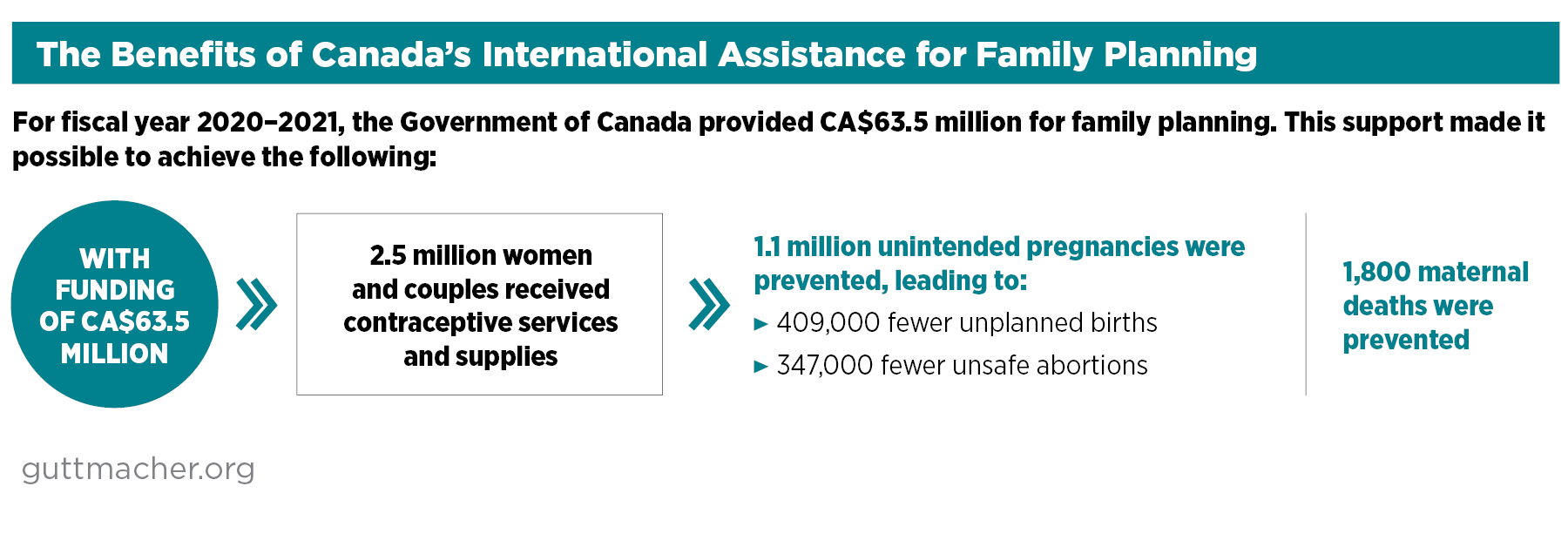Investments in sexual and reproductive health and rights (SRHR) have profound and measurable benefits: Not only do they promote health and well-being throughout people’s lives, but they can also lead to improvements in education, gender equality, political stability, economic development and environmental sustainability.1
Canada’s support for family planning
Canada has made strong and bold commitments for investments in the health, rights and well-being of women and girls worldwide. In 2019, the Government of Canada announced that it would dedicate CA$700 million per year for 10 years, starting in 2023, to support women’s and girls’ SRHR.2 This funding level, supported under the country’s Feminist International Assistance Policy,3 represents a substantial increase from a prior investment of CA$650 million over a three-year period (2017–2020). The impact of these investments will likely be bolstered by Canada’s financial commitments made through the 2021 Generation Equality Forum to address gender-based inequalities.4
Canada’s focus on SRHR prioritizes areas that are often neglected in foreign assistance: family planning and contraceptive care, comprehensive sexuality education, safe and legal abortion, and advocacy for SRHR. This focus also includes accountability mechanisms for tracking support in these neglected areas and resulting outcomes.
Family planning and contraceptive care is part of an essential, comprehensive package of SRHR services and information.1 Investments in expanding access to this full range of services have substantial health impacts,5 and they are especially needed in countries and contexts where health systems are already weak or strained by challenges such as the COVID-19 pandemic. Canada’s funding for family planning also helps to respect, protect and fulfill the fundamental human right of women and girls to have control over their own sexual and reproductive health choices, which is foundational for reducing gender inequality and addressing its root causes.
Canada’s level of investment for family planning during fiscal year 2020–2021 (from April 2020 through March 2021) is expected to have increased the numbers of contraceptive users served and unintended pregnancies prevented—and therefore decreased unplanned births, unsafe abortions and maternal deaths. The continued investment in family planning made by Canada, especially as countries grapple with the effects of COVID-19, represents a sizable contribution to global health.
Fully investing in family planning as part of an essential package of health services not only saves lives and improves adolescents’ and women’s health and well-being—it also results in cost savings. Evidence for 132 low- and middle-income countries in 2019 shows that, on average, every US dollar spent on contraceptive services beyond the current level would reduce the cost of maternal, newborn and abortion care by three dollars,5 and it would lead to cost savings at the country level as well.6
Methodology and sources
Canada’s funding for family planning allocations by country and region includes bilateral amounts coded to the Development Assistance Committee (DAC) purpose code 13030 (family planning), as well as core funding to the United Nations Population Fund and to UN Women. Figures represent fiscal year (FY) 2020–2021 (April 1 to March 31) in Canadian dollars. Amounts do not include family planning delivered through humanitarian assistance, which is coded to the DAC emergency response purpose codes.7 Global Affairs Canada considers FY 2020–2021 funding information preliminary until final verification, in March 2022. Technical information used to generate these results is available at https://osf.io/5kdfz/.
To estimate the annual number of contraceptive users served by funding in FY 2020–2021, we divided annual funding by the average annual cost of contraceptive use, which comes from the most recent comprehensive analysis of costs and impacts of family planning in low- and middle-income countries.5,8 Country-level per-user costs were updated to 2020 US dollars and converted to Canadian dollars. We estimated country-level impacts from 2019 findings from the same analysis. Annual total impacts were estimated as the difference between the annual number of events expected to occur among women using modern methods and the number that would occur if they relied instead on traditional methods or no method.
Though we used a similar methodology for both time periods, Just the Numbers estimates for 2020–2021 have updated impact and cost data and are not directly comparable to the prior iteration of this analysis, which covered fiscal year 2017–2018. The approach to estimating total funding for family planning is largely consistent and comparable between the two time periods.

